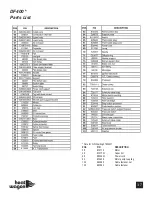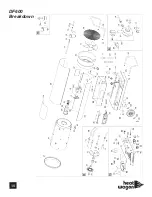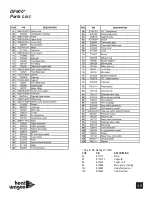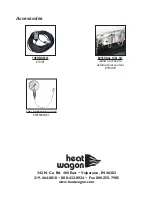
ADVANCED TROUBLESHOOTING CONTINUED
Heater ignites, but combustion is poor or uneven.
Causes:
1. Fuel pump is defective.
2. Spray nozzle clogged.
3. Fuel filter dirty.
4. Spark plug or electrode(s) not gapped or positioned properly.
5. Weak spark output from transformer.
6. Fuel contaminated by water or impurities.
Solutions:
1. Fuel pump is defective.
See “6. Fuel pump is defective”
2. Spray nozzle clogged.
See “2. Spray nozzle clogged”
3. Fuel filter dirty.
See “1. Fuel filter dirty”
4. Spark plug or electrode(s) not gapped or positioned properly.
See page 4.
5. Weak spark from transformer.
See “9. Defective transformer”
6. Fuel contaminated by water or impurities.
Using a flashlight, inspect the fuel in the tank for water or impurities. Bubbles on the bottom of the tank indicate water in the fuel tank. Water
can be removed from the tank by adding an additive to the tank that is designed to dry up moisture in fuel tanks. This type of additive can be
purchased at most automotive supply stores. This is also advisable if the fuel filter contains water or impurities.
Motor and transformer do not operate.
Causes:
1. Incorrect or low voltage supplied to the heater.
2. Fuse in heater is blown. (no green light)
3. Thermostat defective, or not turned up to call for heat.
4. Control board is defective.
5. Reset button has not been reset. (red light on)
6. Wiring disconnected, loose or incorrect.
Solutions:
1. Incorrect or low voltage supplied to the heater. Most oil heaters require a minimum of 108 volts to operate properly. A multi-meter set to
measure volts can be used to check the amount of voltage at the end of the extension cord(s). If the measured voltage is too low, the length of
the extension cord (s) must be shortened or a thicker gauge extension cord must be used.
2. Fuse in heater is blown. Locate and remove the in-line fuse of the heater. Set a multi-meter to measure ohms of resistance. Place a multi-
meter probe on each end of the fuse. The multi-meter should read zero ohms (continuity) or the fuse is blown. If a new fuse blows immediate-
ly, check for possible causes. Check for incorrect voltage to the heater. Make sure the total amperage draw of all equipment running on the cir-
cuit is not too great. If the supplied voltage and total amperage draw are correct, check the wiring in the heater for correctness and possible
shorts.
9
Summary of Contents for DF400
Page 5: ...5 ...
Page 6: ...6 See page 11 ...
Page 12: ...165 28 N 7 5 2 00 80ºS 190 Technical Specifications N 12 ...
Page 14: ...14 DF400 Wiring Diagram SN 276000401 and Beyond CAPACITOR P N E10325 ...
Page 15: ...15 DF600 Wiring Diagram SN 277000401 and Beyond CAPACITOR P N E10325 ...
Page 16: ...16 DF400 Breakdown ...
Page 18: ...DF600 Breakdown 18 ...






































